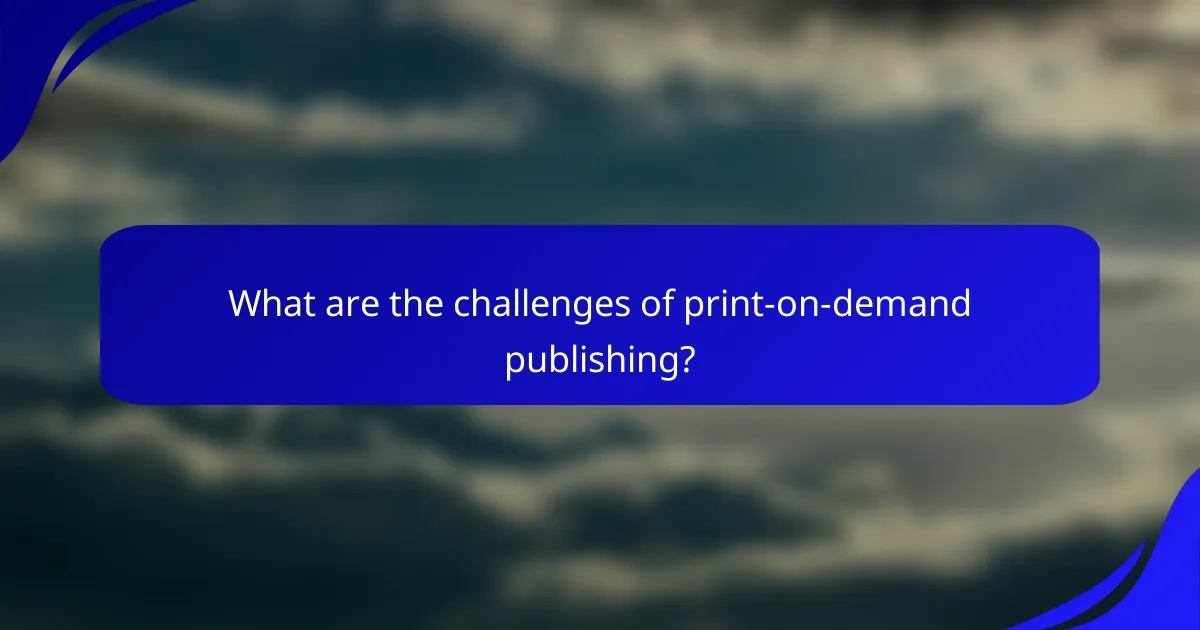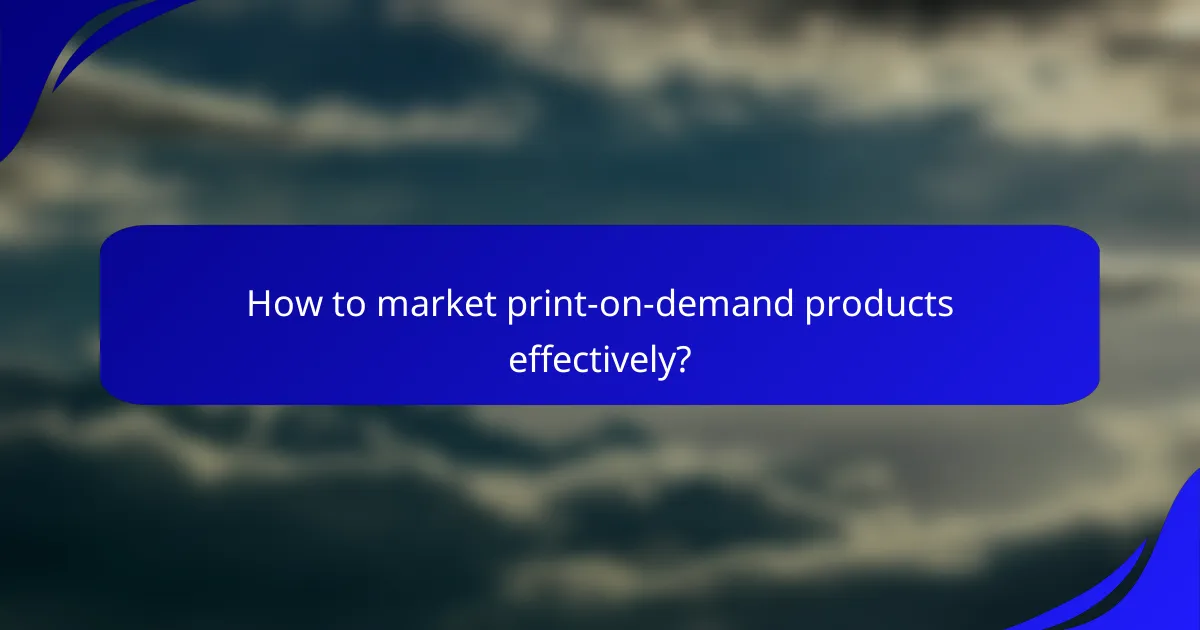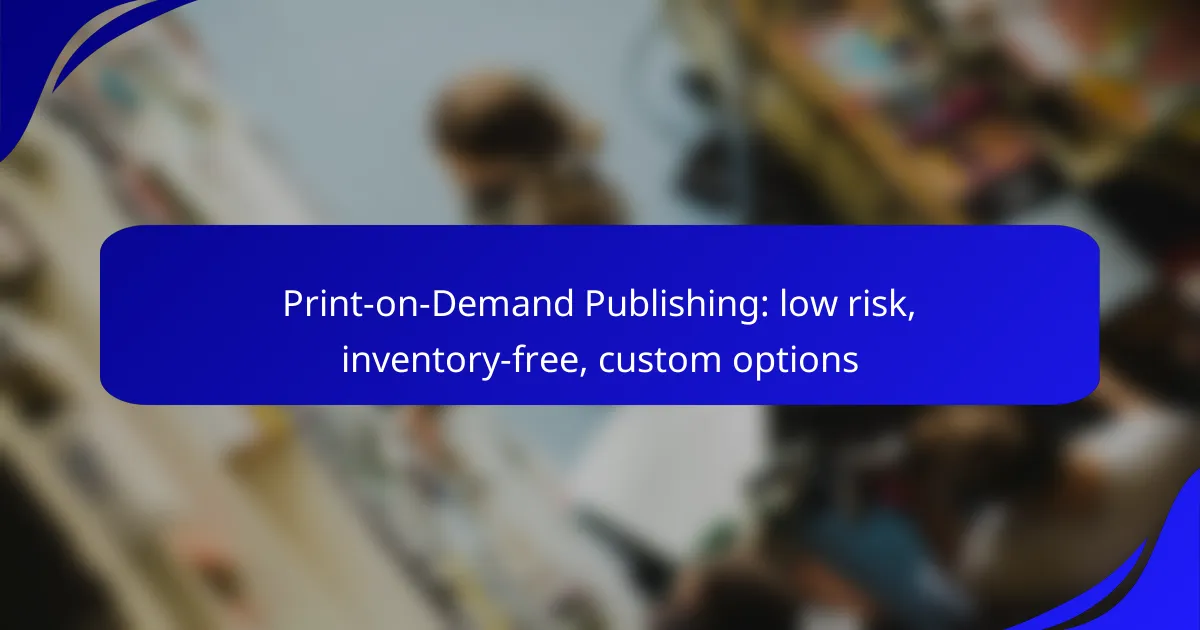Print-on-demand (POD) publishing offers a revolutionary approach for authors and creators by allowing them to print books or products only when an order is placed, thereby eliminating the need for inventory. This low-risk model not only minimizes financial investment but also provides flexibility and customization options, making it an attractive choice for those looking to enter the publishing market without the burden of upfront costs.

How does print-on-demand publishing work in the UK?
Print-on-demand (POD) publishing in the UK allows authors and creators to print books or products only when an order is placed, eliminating the need for inventory. This model reduces financial risk and provides a customizable approach to publishing.
On-demand printing process
The on-demand printing process involves digital printing technology that produces copies of a book or product only after a customer places an order. This method is efficient and cost-effective, as it eliminates the need for large print runs and storage costs.
Typically, a creator uploads their digital files to a POD platform, which then handles the printing and binding. The quality of the print can vary, so it’s essential to choose a reputable provider that meets your standards.
Order fulfillment model
The order fulfillment model in print-on-demand publishing is straightforward. Once an order is received, the POD service prints the item and ships it directly to the customer. This process allows creators to focus on marketing and content creation rather than logistics.
In the UK, many POD services offer integration with online marketplaces, enabling seamless sales through platforms like Amazon or Etsy. Creators should consider shipping times and costs, as these can impact customer satisfaction and overall sales.

What are the benefits of print-on-demand publishing?
Print-on-demand publishing offers several advantages, including minimal financial risk and the elimination of inventory management. This model allows creators to produce books or products only when ordered, providing flexibility and reducing upfront costs.
No inventory costs
One of the primary benefits of print-on-demand publishing is the absence of inventory costs. Since products are printed only after a customer places an order, there is no need to invest in large quantities of stock. This significantly lowers the financial risk for authors and businesses.
Additionally, without the burden of unsold inventory, creators can focus on marketing and improving their offerings. This model is particularly advantageous for niche markets where demand may be unpredictable.
Customizable products
Print-on-demand services allow for a high degree of customization in products. Authors can choose from various formats, sizes, and cover designs, tailoring their books to meet specific audience preferences. This flexibility can enhance the appeal of a product and increase sales potential.
Moreover, customization extends beyond just books; creators can offer personalized merchandise, such as apparel or home goods. This ability to provide unique products can help differentiate a brand in a competitive market.

What are the best platforms for print-on-demand publishing in the UK?
The best platforms for print-on-demand publishing in the UK include Printful, Redbubble, and IngramSpark. Each offers unique features and pricing structures that cater to different needs, making it essential to evaluate them based on your specific publishing goals.
Printful
Printful is a popular choice for print-on-demand services, known for its seamless integration with various e-commerce platforms. It allows creators to design and sell custom products without holding inventory, making it ideal for those looking to minimize risk.
With Printful, you can create a wide range of items, from apparel to home decor. Pricing is based on production costs plus shipping, so it’s crucial to factor in these expenses when setting your retail prices to ensure profitability.
Redbubble
Redbubble is a user-friendly platform that enables artists to sell their designs on a variety of products, including clothing, stickers, and wall art. It operates on a marketplace model, meaning you can reach a broad audience without needing to drive traffic to your own site.
Artists earn a commission on each sale, which can vary based on the product type and pricing strategy. Redbubble handles production and shipping, allowing you to focus solely on creating and promoting your artwork.
IngramSpark
IngramSpark is tailored for authors and publishers looking to distribute printed books and eBooks globally. It offers extensive distribution channels, including bookstores and libraries, making it a strong option for serious authors.
While there are setup fees involved, IngramSpark provides a professional publishing experience with high-quality printing options. Consider the initial costs and ongoing royalties when deciding if this platform aligns with your publishing ambitions.

How to choose the right print-on-demand service?
Choosing the right print-on-demand service involves evaluating factors like pricing, product variety, and shipping options. Prioritize services that align with your specific needs, such as budget constraints and target audience preferences.
Pricing structures
Pricing structures can vary significantly among print-on-demand services. Some charge a flat fee per item, while others may have tiered pricing based on order volume. Look for services that offer transparent pricing without hidden fees.
Consider additional costs such as setup fees, shipping rates, and potential discounts for bulk orders. A good practice is to compare several services to find the most cost-effective option for your business model.
Product range
The product range offered by print-on-demand services can greatly influence your brand’s appeal. Many platforms provide a variety of items, from apparel to home decor, allowing for customization and unique designs.
Evaluate the quality of products available, as well as the printing techniques used. Some services may specialize in specific niches, so ensure their offerings align with your target market’s interests.
Shipping options
Shipping options are crucial for customer satisfaction and can affect your overall sales. Look for print-on-demand services that provide multiple shipping methods, including standard and expedited options, to cater to different customer needs.
Check if the service offers international shipping and what the associated costs are. Fast and reliable shipping can enhance your brand’s reputation, so prioritize services with good delivery track records.

What are the challenges of print-on-demand publishing?
Print-on-demand publishing presents several challenges that can affect the overall quality and efficiency of the process. Key issues include maintaining quality control and managing longer shipping times, both of which can impact customer satisfaction and profitability.
Quality control issues
Quality control is a significant concern in print-on-demand publishing, as the final product may vary depending on the printing service used. Inconsistent print quality, color accuracy, and material durability can lead to customer dissatisfaction.
To mitigate these risks, it is essential to choose a reputable print-on-demand provider with a track record of quality. Requesting samples before committing to a large order can help ensure that the final product meets expectations.
Longer shipping times
Shipping times in print-on-demand publishing can be longer compared to traditional publishing methods, as each item is printed after an order is placed. This can result in delivery times ranging from several days to a few weeks, depending on the provider and the customer’s location.
To address this challenge, consider clearly communicating estimated shipping times to customers at the point of sale. Offering expedited shipping options may also help improve customer satisfaction and reduce the impact of longer delivery periods.

How to market print-on-demand products effectively?
To market print-on-demand products effectively, focus on building a strong online presence through targeted strategies. Utilize social media platforms and optimize your product listings for search engines to reach potential customers and drive sales.
Social media strategies
Social media is a powerful tool for promoting print-on-demand products. Create engaging content that showcases your designs and connects with your audience. Use platforms like Instagram and Facebook to share high-quality images, customer testimonials, and behind-the-scenes looks at your creative process.
Consider running targeted ads to reach specific demographics. Use analytics tools to track engagement and adjust your strategies based on what resonates with your audience. Regularly interact with followers to build a community around your brand.
SEO for product listings
Optimizing your product listings for search engines is crucial for visibility. Start by conducting keyword research to identify terms potential customers are using to find products like yours. Incorporate these keywords naturally into your product titles, descriptions, and tags.
Ensure your listings are clear and informative, highlighting unique features and benefits. Use high-quality images and include alt text for better indexing. Regularly update your listings based on performance metrics to improve search rankings and attract more traffic.

What are the future trends in print-on-demand publishing?
Future trends in print-on-demand publishing include increased customization, technological advancements, and a growing focus on sustainability. As consumer preferences shift towards personalized products, the industry is adapting to meet these demands while leveraging new technologies to enhance efficiency.
Increased Customization Options
Print-on-demand services are moving towards offering more customization options for consumers. This includes choices in materials, sizes, and finishes, allowing authors and businesses to create unique products that cater to specific audiences. For instance, a self-published author might choose different cover designs or paper types to appeal to various reader demographics.
As customization becomes more prevalent, platforms may introduce user-friendly tools that enable easy design modifications. This trend not only enhances customer satisfaction but also encourages repeat purchases, as buyers are likely to return for more tailored offerings.
Technological Advancements
Advancements in printing technology are set to revolutionize the print-on-demand landscape. Innovations such as improved digital printing techniques and automation are making it possible to produce high-quality products more quickly and at lower costs. This efficiency allows businesses to respond to market demands swiftly without the burden of excess inventory.
Additionally, the integration of artificial intelligence in design and production processes can streamline operations. For example, AI can assist in predicting trends and optimizing print runs, ensuring that businesses remain competitive in a fast-evolving market.
Focus on Sustainability
As environmental concerns grow, print-on-demand publishers are increasingly prioritizing sustainable practices. This includes using eco-friendly materials, such as recycled paper and non-toxic inks, which appeal to environmentally conscious consumers. Implementing sustainable practices not only helps the planet but can also enhance a brand’s reputation.
Moreover, the print-on-demand model itself promotes sustainability by reducing waste associated with unsold inventory. Businesses can produce items only as needed, minimizing their environmental footprint while still meeting customer demands effectively.
